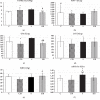Sitagliptin-Dependent Differences in the Intensity of Oxidative Stress in Rat Livers Subjected to Ischemia and Reperfusion
- PMID: 31781329
- PMCID: PMC6875175
- DOI: 10.1155/2019/2738605
Sitagliptin-Dependent Differences in the Intensity of Oxidative Stress in Rat Livers Subjected to Ischemia and Reperfusion
Abstract
Purpose: Ischemia/reperfusion (IR) is the main cause of liver damage after transplantation. We evaluated the effect of sitagliptin (STG) on oxidative stress parameters in the rat liver under IR.
Methods: Rats were treated with STG (5 mg/kg) (S and SIR) or saline solution (C and CIR). Livers from CIR and SIR were subjected to ischemia (60 min) and reperfusion (24 h). During reperfusion, aminotransferases (ALT and AST) were determined in blood samples. Thiobarbituric acid reactive substances (TBARS), superoxide dismutase (SOD), catalase (CAT), paraoxonase-1 (PON1), glutathione peroxidase (GPx), and the mRNA expression of SOD1 were determined in liver homogenates after reperfusion. Different regions of livers were also histologically evaluated.
Results: The PON1 activity was higher, and the TBARS level was lower in SIR than in CIR. There was an inverse relationship between TBARS and PON1 levels in the whole cohort. The GPx activity was lower in ischemic than in nonischemic groups regardless of the STG treatment. In SIR, the SOD1 activity was higher compared to that in CIR. In S, the expression of SOD1 mRNA was the highest of all examined groups and positively correlated with the SOD1 activity in the whole animal cohort. During IR aminotransferases, the activity in the drug-treated group was lower in all examined points of time. In drug-treated groups, the percentage of steatosis was higher than that in nontreated groups regardless of IR.
Conclusions: The protective effect of STG on the rat liver, especially its antioxidant properties, was revealed under IR conditions.
Copyright © 2019 Małgorzata Trocha et al.
Conflict of interest statement
The authors declare that there is no conflict of interest.
Figures




References
MeSH terms
Substances
LinkOut - more resources
Full Text Sources
Miscellaneous

